

Compact Muon Solenoid
LHC, CERN
| CMS-PAS-SUS-16-027 | ||
| Search for direct top squark pair production in the dilepton final state at $\sqrt{s}= $ 13 TeV | ||
| CMS Collaboration | ||
| October 2016 | ||
| Abstract: We present a search for direct top squark production in the opposite-sign dilepton channel using LHC pp collision data at $\sqrt{s}= $ 13 TeV amounting to 12.9 fb$^{-1}$ collected by the CMS detector in 2016. The search is performed in final states with two leptons, electrons or muons, jets, of which at least one is b-tagged, and missing transverse momentum. Signal regions are defined using transverse mass variables, which efficiently separate the signal from the dominant top-quark pair background. No significant deviation from the background prediction is observed. Exclusion limits are set in the context of a simplified supersymmetric model with pair production of top squarks that each decay to a top quark and a neutralino. For neutralino masses below 150 GeV, masses of the lightest top squark below 650 GeV are excluded at a confidence level of 95%. | ||
| Links: CDS record (PDF) ; inSPIRE record ; CADI line (restricted) ; | ||
| Figures | |
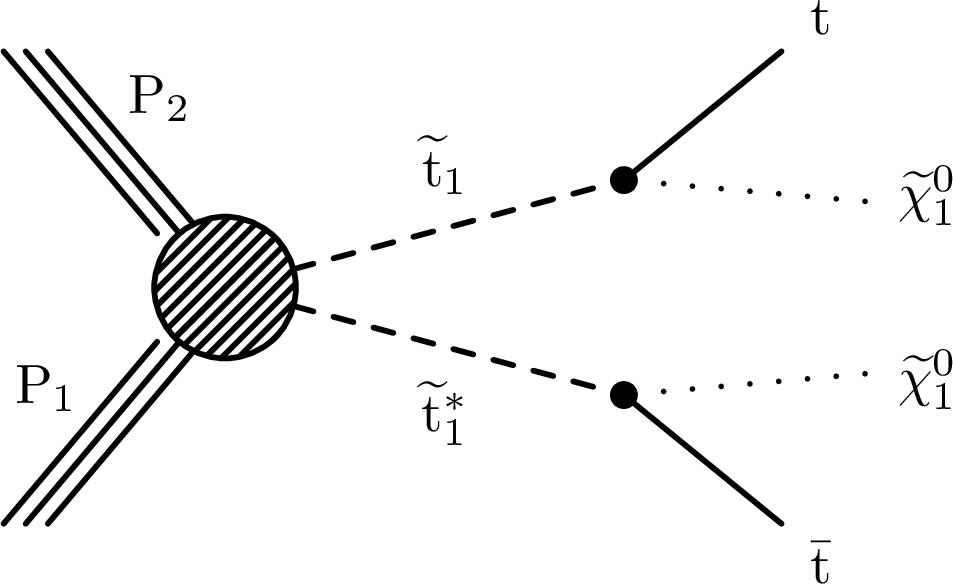
png pdf |
Figure 1:
Production of a top squark pair ($\tilde{\mathrm{t}}\tilde{\mathrm{t}}^*$) in a simplified model of strongly produced top squark pairs. Each of the top squarks decays into a top quark and a neutralino ($\tilde{\chi}^0_1 $). |
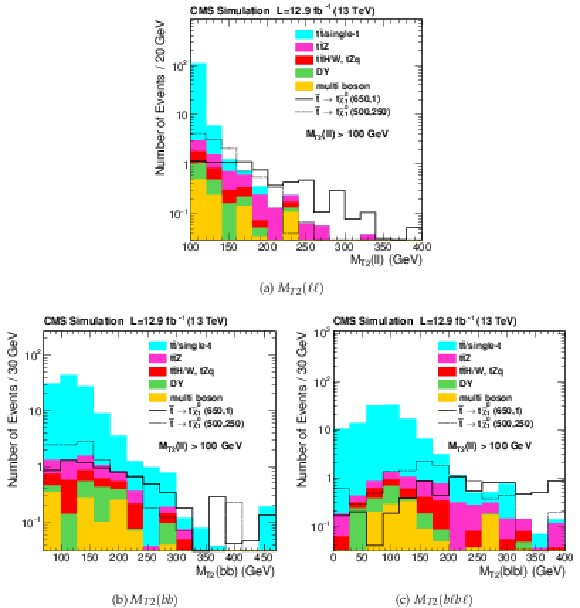
png pdf |
Figure 2:
Distributions of ${M_{\mathrm{T2}}(\ell \ell )} $, ${M_{\mathrm{T2}}(\mathrm{ bb })} $, and ${M_{\mathrm{T2}}(\mathrm{ b\ell b\ell } )}$ after preselection and requiring $ {M_{\mathrm{T2}}(\ell \ell )} > $ 100 GeV. |
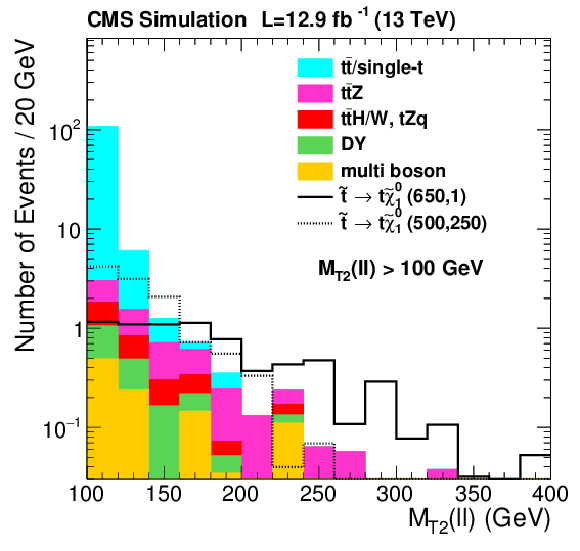
png pdf |
Figure 2-a:
Distribution of ${M_{\mathrm{T2}}(\ell \ell )} $ after preselection and requiring $ {M_{\mathrm{T2}}(\ell \ell )} > $ 100 GeV. |
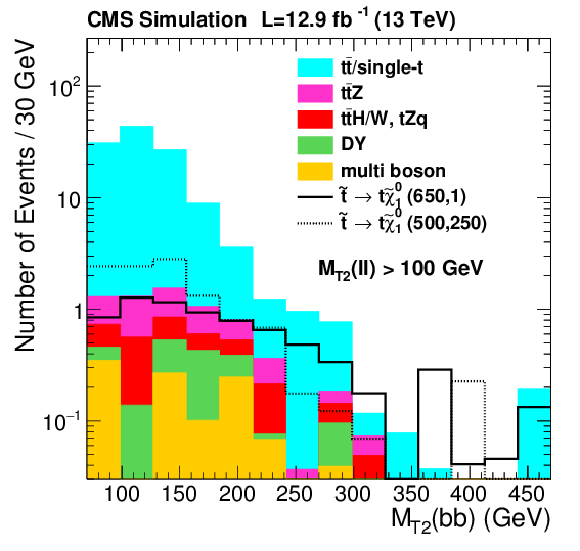
png pdf |
Figure 2-b:
Distribution of ${M_{\mathrm{T2}}(\mathrm{ bb })} $ after preselection and requiring $ {M_{\mathrm{T2}}(\ell \ell )} > $ 100 GeV. |
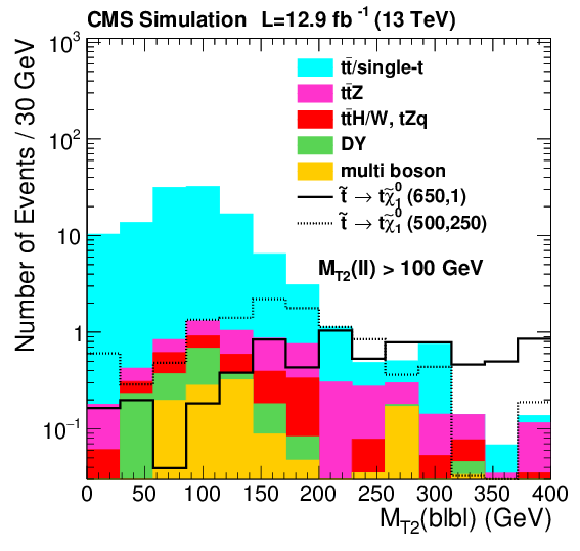
png pdf |
Figure 2-c:
Distribution of ${M_{\mathrm{T2}}(\mathrm{ b\ell b\ell } )}$ after preselection and requiring $ {M_{\mathrm{T2}}(\ell \ell )} > $ 100 GeV. |

png pdf |
Figure 3:
${M_{\mathrm{T2}}(\ell \ell )}$ distributions in two control regions enriched by $\mathrm{ t \bar{t} }$ events. Simulated yields are normalized to data using the yields at $ {M_{\mathrm{T2}}(\ell \ell )} < $ 100 GeV. |
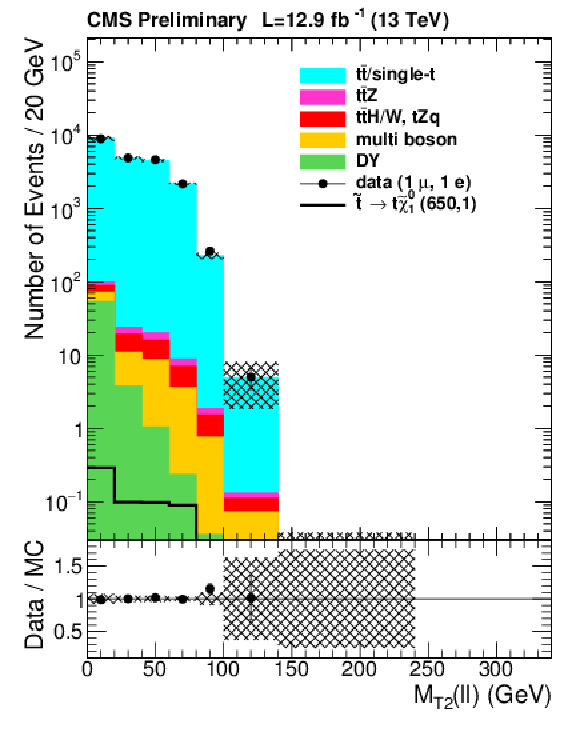
png pdf |
Figure 3-a:
${M_{\mathrm{T2}}(\ell \ell )}$ distribution in one of the $\mathrm{e}\mu$ control regions enriched in $\mathrm{ t \bar{t} }$ events. Simulated yields are normalized to data using the yields at $ {M_{\mathrm{T2}}(\ell \ell )} < $ 100 GeV. |
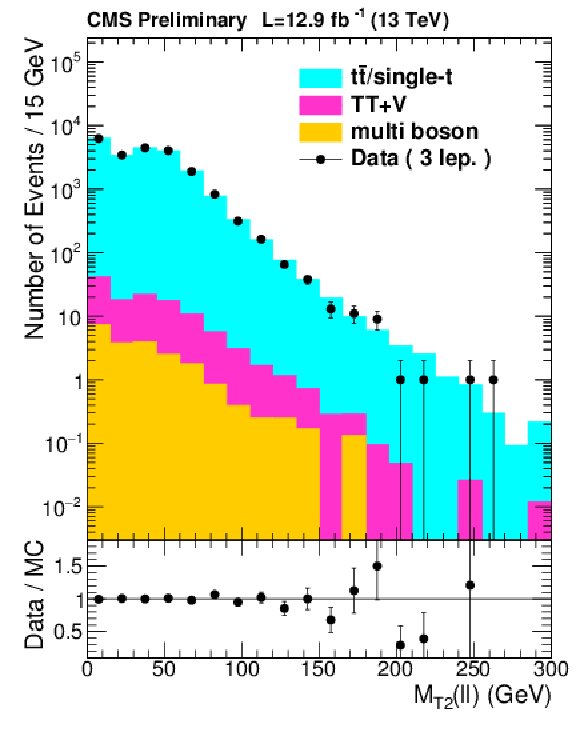
png pdf |
Figure 3-b:
${M_{\mathrm{T2}}(\ell \ell )}$ distributions in the control region with two tight and one loose leptons enriched in $\mathrm{ t \bar{t} }$ events. Simulated yields are normalized to data using the yields at $ {M_{\mathrm{T2}}(\ell \ell )} < $ 100 GeV. |
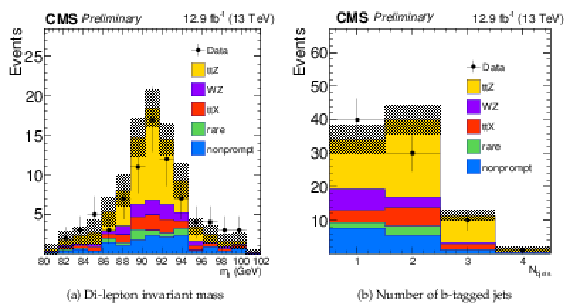
png pdf |
Figure 4:
Control region used for normalization of the ${{\mathrm{ t } {}\mathrm{ \bar{t} } } \mathrm{ Z } }$ process. The hatched band contains the uncertainties due to luminosity, jet energy scale, jet energy resolution, trigger efficiencies, b-tagging efficiencies, lepton selection efficiencies, pileup reweighting, scale and PDF uncertainties as well as the uncertainties due to non-prompt leptons and other SM processes. |
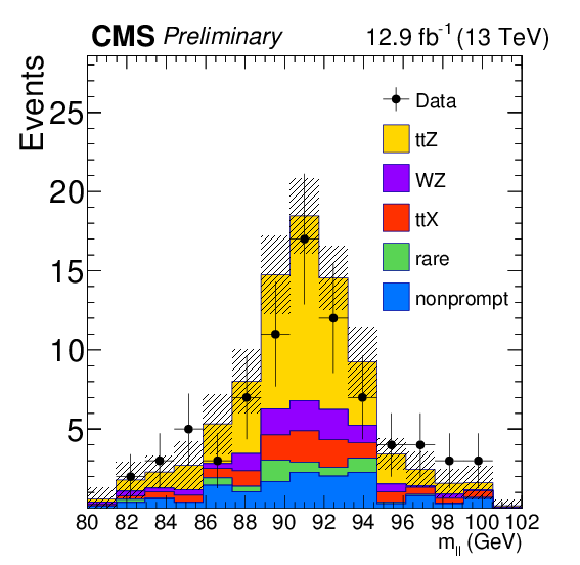
png pdf |
Figure 4-a:
Dilepton invariant mass distribution in the control region used for normalization of the ${{\mathrm{ t } {}\mathrm{ \bar{t} } } \mathrm{ Z } }$ process. The hatched band contains the uncertainties due to luminosity, jet energy scale, jet energy resolution, trigger efficiencies, b-tagging efficiencies, lepton selection efficiencies, pileup reweighting, scale and PDF uncertainties as well as the uncertainties due to non-prompt leptons and other SM processes. |

png pdf |
Figure 4-b:
Number of b-tagged jets distribution in the control region used for normalization of the ${{\mathrm{ t } {}\mathrm{ \bar{t} } } \mathrm{ Z } }$ process. The hatched band contains the uncertainties due to luminosity, jet energy scale, jet energy resolution, trigger efficiencies, b-tagging efficiencies, lepton selection efficiencies, pileup reweighting, scale and PDF uncertainties as well as the uncertainties due to non-prompt leptons and other SM processes. |
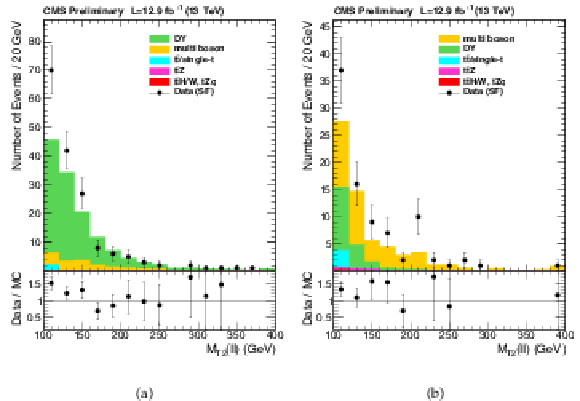
png pdf |
Figure 5:
Distributions of ${M_{\mathrm{T2}}(\ell \ell )}$ in a DY (left) and diboson (right) dominated region for same-flavor ($\mathrm{ee}$/$\mu \mu $) events falling within the Z-mass window, $ {N_\text {jets}} \geq $ 2 and no b-tagged jets. |

png pdf |
Figure 5-a:
Distribution of ${M_{\mathrm{T2}}(\ell \ell )}$ in a DY dominated region for same-flavor ($\mathrm{ee}$/$\mu \mu $) events falling within the Z-mass window, $ {N_\text {jets}} \geq $ 2 and no b-tagged jets. |

png pdf |
Figure 5-b:
Distribution of ${M_{\mathrm{T2}}(\ell \ell )}$ in a diboson dominated region for same-flavor ($\mathrm{ee}$/$\mu \mu $) events falling within the Z-mass window, $ {N_\text {jets}} \geq $ 2 and no b-tagged jets. |
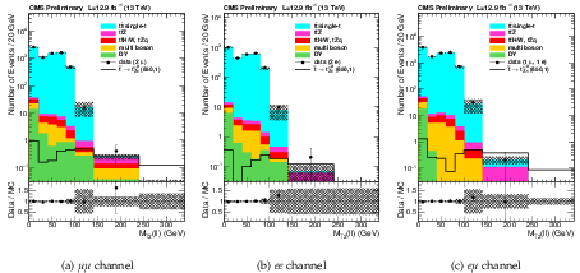
png pdf |
Figure 6:
$ {M_{\mathrm{T2}}(\ell \ell )} $ distributions of observed events in $\mu \mu $, $\mathrm{ee}$, $\mathrm{e}\mu $ channels compared to the predicted SM backgrounds using simulation in the selection defined in Table 1. The shaded band covers all uncertainties discussed in the text. |
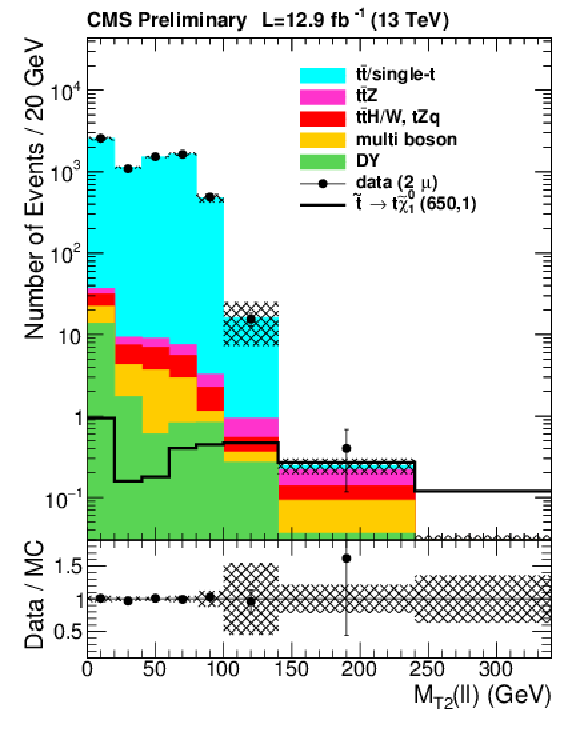
png pdf |
Figure 6-a:
$ {M_{\mathrm{T2}}(\ell \ell )} $ distribution of observed events in the $\mu \mu $ channel compared to the predicted SM backgrounds using simulation in the selection defined in Table 1. The shaded band covers all uncertainties discussed in the text. |
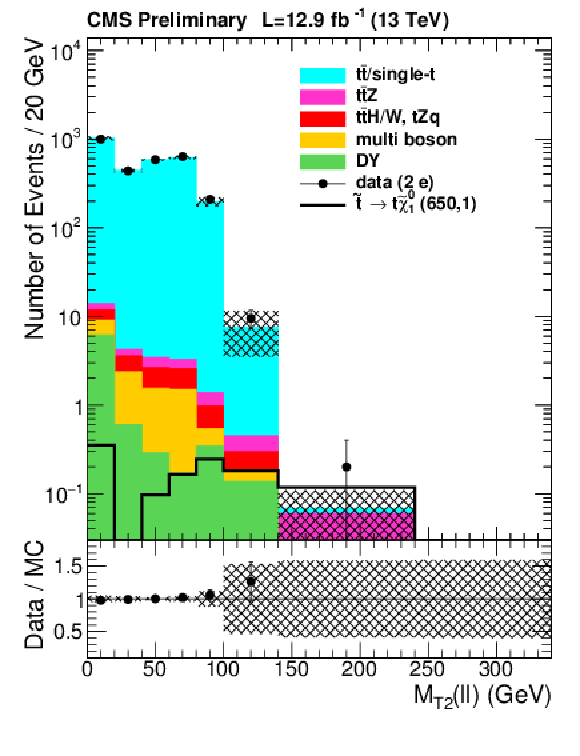
png pdf |
Figure 6-b:
$ {M_{\mathrm{T2}}(\ell \ell )} $ distribution of observed events in the $\mathrm{ee}$ channel compared to the predicted SM backgrounds using simulation in the selection defined in Table 1. The shaded band covers all uncertainties discussed in the text. |
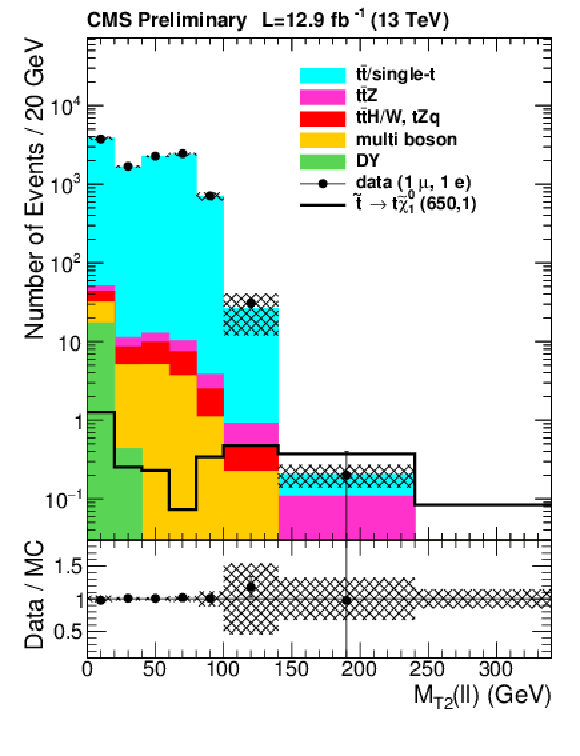
png pdf |
Figure 6-c:
$ {M_{\mathrm{T2}}(\ell \ell )} $ distribution of observed events in the $\mathrm{e}\mu $ channel compared to the predicted SM backgrounds using simulation in the selection defined in Table 1. The shaded band covers all uncertainties discussed in the text. |

png pdf |
Figure 7:
Distributions of ${M_{\mathrm{T2}}(\mathrm{ b\ell b\ell } )}$ and ${M_{\mathrm{T2}}(\mathrm{ \mathrm{ bb } })}$ in all flavor channels for the selection defined in Table 1 and for $ {M_{\mathrm{T2}}(\ell \ell )} > $ 100 GeV. The shaded band covers all uncertainties discussed in the text. |
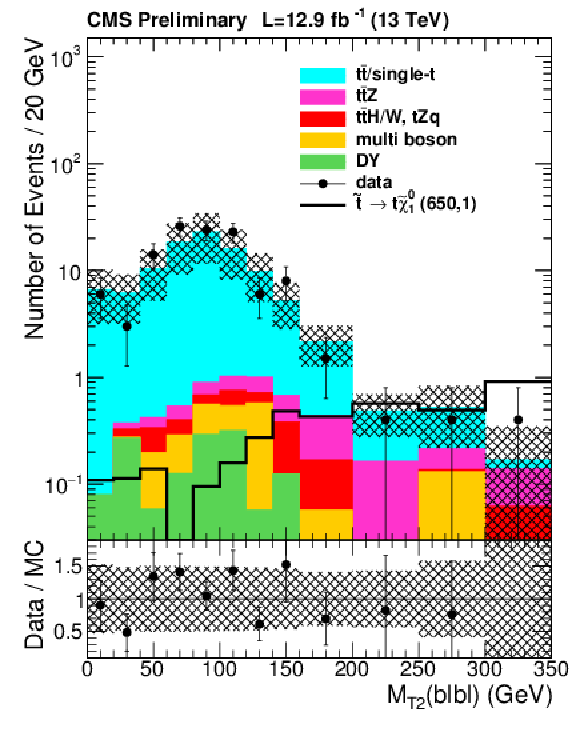
png pdf |
Figure 7-a:
Distribution of ${M_{\mathrm{T2}}(\mathrm{ b\ell b\ell } )}$ in all flavor channels for the selection defined in Table 1 and for $ {M_{\mathrm{T2}}(\ell \ell )} > $ 100 GeV. The shaded band covers all uncertainties discussed in the text. |
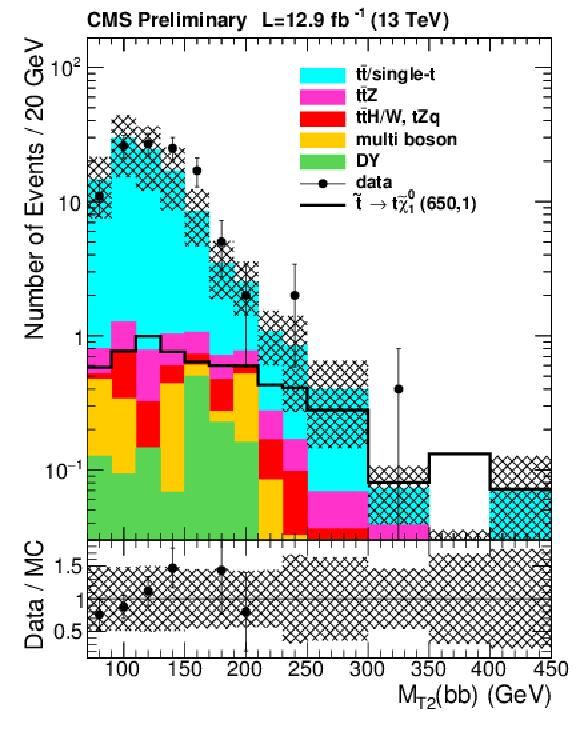
png pdf |
Figure 7-b:
Distribution of ${M_{\mathrm{T2}}(\mathrm{ \mathrm{ bb } })}$ in all flavor channels for the selection defined in Table 1 and for $ {M_{\mathrm{T2}}(\ell \ell )} > $ 100 GeV. The shaded band covers all uncertainties discussed in the text. |
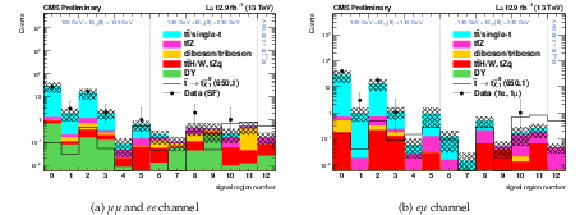
png pdf |
Figure 8:
Predicted backgrounds and observed yields in each search region. The shaded band covers all uncertainties discussed in the text. |

png pdf |
Figure 8-a:
Predicted backgrounds and observed yields in each search region ($\mathrm{ee}$/$\mumu$ channels). The shaded band covers all uncertainties discussed in the text. |
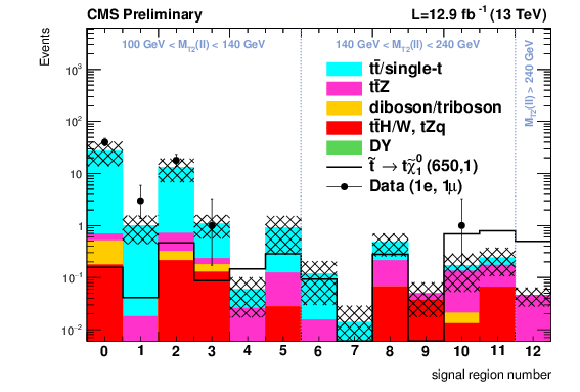
png pdf |
Figure 8-b:
Predicted backgrounds and observed yields in each search region ($\mathrm{e}\mu$ channel). The shaded band covers all uncertainties discussed in the text. |
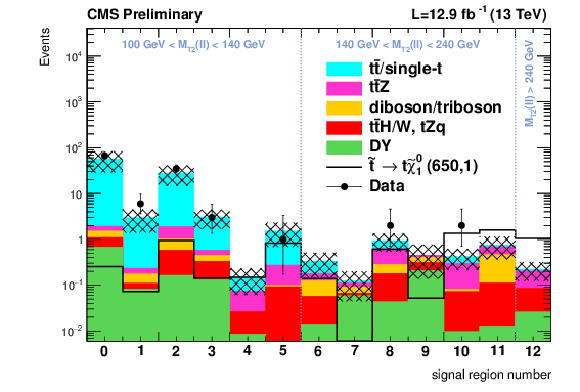
png pdf |
Figure 9:
Same as Fig. 8 but channels combined. |
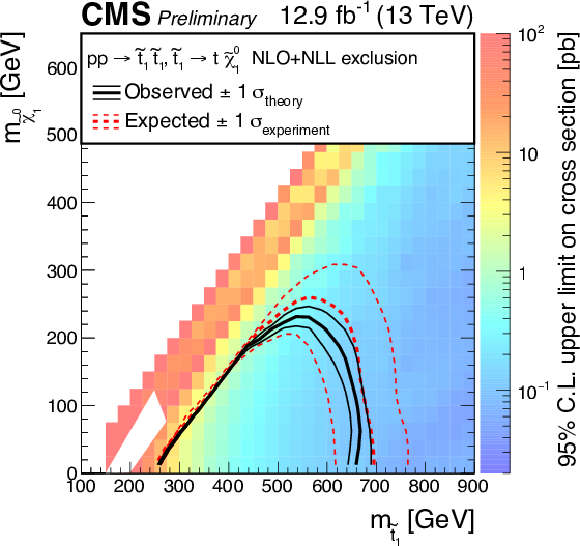
png pdf |
Figure 10:
95% CL expected and observed limits for the $\tilde{ \mathrm{ t } } \to \mathrm{t}\tilde{\chi}^0_1 $ decay mode in the $m_{\tilde{ \mathrm{ t } } }$, $m_{\tilde{\chi}^0_1 }$ mass plane |
| Tables | |
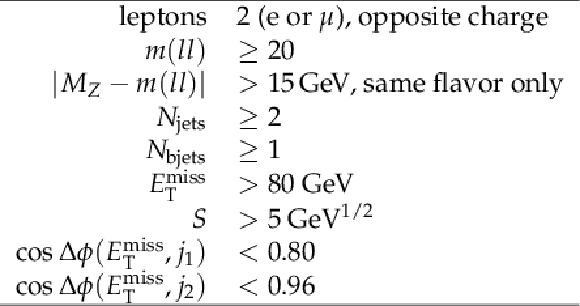
png pdf |
Table 1:
Overview of the preselection. |

png pdf |
Table 2:
Definition of the signal regions. |

png pdf |
Table 3:
Minimal and maximal relative errors for the systematic uncertainties over all signal regions in Fig. 9. Numbers are given relative to the total background contribution per signal region. |

png pdf |
Table 4:
Yields for data and total expected background in each of the signal regions for same-flavor ($\mathrm{ee}$/$\mu \mu $), different-flavor ($\mathrm{e}\mu $) and all channels combined with all systematic uncertainties as described in Sec. {sec:systematics}. |
| Summary |
| We presented a search for supersymmetry in a final state of two leptons, b jets, and large missing transverse momentum, originating from decays of pair-produced top squarks to two top quarks and neutralinos, with a subsequent fully leptonic decay of the top quarks. We used a data set corresponding to an integrated luminosity of 12.9 fb$^{-1}$ of pp collisions collected in 2016 at a center-of-mass energy of 13 TeV with the CMS detector at the LHC. An efficient background reduction using dedicated kinematical variables was achieved, with in particular the large background of SM dilepton $\mathrm{ t \bar{t} }$ events suppressed by several orders of magnitude. We observe no evidence for an excess above the expected background from standard model processes. For neutralino masses of $m_{\tilde{\chi}^0_1} \leq $ 150 GeV, mass configurations with $m_{\tilde{\mathrm{t}}} \leq $ 650 GeV are excluded at a confidence level of 95%. |
| References | ||||
| 1 | P. Ramond | Dual theory for free fermions | PRD 3 (1971) 2415 | |
| 2 | Y. A. Golfand and E. P. Likhtman | Extension of the algebra of Poincare group generators and violation of P invariance | JEPTL 13 (1971)323 | |
| 3 | A. Neveu and J. H. Schwarz | Factorizable dual model of pions | Nucl. Phys. B 31 (1971) 86 | |
| 4 | D. V. Volkov and V. P. Akulov | Possible universal neutrino interaction | JEPTL 16 (1972)438 | |
| 5 | J. Wess and B. Zumino | A Lagrangian model invariant under supergauge transformations | PLB 49 (1974) 52 | |
| 6 | J. Wess and B. Zumino | Supergauge transformations in four dimensions | Nucl. Phys. B 70 (1974) 39 | |
| 7 | P. Fayet | Supergauge invariant extension of the Higgs mechanism and a model for the electron and its neutrino | Nucl. Phys. B 90 (1975) 104 | |
| 8 | H. P. Nilles | Supersymmetry, supergravity and particle physics | Phys. Rep. 110 (1984) 1 | |
| 9 | G. R. Farrar and P. Fayet | Phenomenology of the production, decay, and detection of new hadronic states associated with supersymmetry | PLB 76 (1978) 575 | |
| 10 | ATLAS Collaboration | ATLAS Run 1 searches for direct pair production of third-generation squarks at the Large Hadron Collider | EPJC7 5 (2015) 510 | 1506.08616 |
| 11 | CMS Collaboration | Search for supersymmetry in events with soft leptons, low jet multiplicity, and missing transverse energy in proton-proton collisions at $ \sqrt{s} $ = 8 TeV | PLB 759 (2016) 9 | CMS-SUS-14-021 1512.08002 |
| 12 | CMS Collaboration | Search for direct top squark pair production in the fully hadronic final state in proton-proton collisions at $ \sqrt{s} = $13 TeV corresponding to an integrated luminosity of 12.9/fb | ||
| 13 | CMS Collaboration | Search for direct top squark pair production in the single lepton final state at $ \sqrt{s}= $ 13 TeV | ||
| 14 | C. G. Lester and D. J. Summers | Measuring masses of semiinvisibly decaying particles pair produced at hadron colliders | PLB 463 (1999) 99 | hep-ph/9906349 |
| 15 | S. Alioli et al. | NLO single-top production matched with shower in POWHEG: $ s $- and $ t $-channel contributions | JHEP 09 (2009) 111 | 0907.4076 |
| 16 | S. Alioli et al. | A general framework for implementing NLO calculations in shower Monte Carlo programs: the POWHEG BOX | JHEP 06 (2010) 043 | 1002.2581 |
| 17 | M. Czakon and A. Mitov | Top++: A Program for the Calculation of the Top-Pair Cross-Section at Hadron Colliders | CPC 185 (2014) 2930 | 1112.5675 |
| 18 | M. Aliev et al. | HATHOR: HAdronic Top and Heavy quarks crOss section calculatoR | CPC 182 (2011) 1034 | 1007.1327 |
| 19 | M. Beneke, P. Falgari, S. Klein, and C. Schwinn | Hadronic top-quark pair production with NNLL threshold resummation | Nucl. Phys. B 855 (2012) 695 | 1109.1536 |
| 20 | M. Czakon and A. Mitov | NNLO corrections to top-pair production at hadron colliders: the all-fermionic scattering channels | JHEP 12 (2012) 054 | 1207.0236 |
| 21 | M. Czakon and A. Mitov | NNLO corrections to top pair production at hadron colliders: the quark-gluon reaction | JHEP 01 (2013) 080 | 1210.6832 |
| 22 | M. Czakon, P. Fiedler, and A. Mitov | Total Top-Quark Pair-Production Cross Section at Hadron Colliders Through $ O(α\frac{4}{S}) $ | PRL 110 (2013) 252004 | 1303.6254 |
| 23 | P. Kant et al. | HatHor for single top-quark production: Updated predictions and uncertainty estimates for single top-quark production in hadronic collisions | CPC 191 (2015) 74--89 | 1406.4403 |
| 24 | J. Alwall et al. | The automated computation of tree-level and next-to-leading order differential cross sections, and their matching to parton shower simulations | JHEP 07 (2014) 079 | 1405.0301 |
| 25 | R. Gavin, Y. Li, F. Petriello, and S. Quackenbush | FEWZ 2.0: A code for hadronic Z production at next-to-next-to-leading order | CPC 182 (2011) 2388--2403 | 1011.3540 |
| 26 | T. Sjostrand, S. Mrenna, and P. Skands | PYTHIA 6.4 physics and manual | JHEP 05 (2006) 026 | hep-ph/0603175 |
| 27 | T. Sjostrand et al. | An Introduction to PYTHIA 8.2 | CPC 191 (2015) 159--177 | 1410.3012 |
| 28 | P. Skands, S. Carrazza, and J. Rojo | Tuning PYTHIA 8.1: the Monash 2013 tune | EPJC 74 (2014) 3024 | 1404.5630 |
| 29 | CMS Collaboration | Event generator tunes obtained from underlying event and multiparton scattering measurements | EPJC 76 (2016) 155 | CMS-GEN-14-001 1512.00815 |
| 30 | GEANT4 Collaboration | GEANT 4 -- a simulation toolkit | NIMA 506 (2003) 250 | |
| 31 | C. Borschensky et al. | Squark and gluino production cross sections in pp collisions at $ \sqrt{s} $ = 13, 14, 33 and 100 TeV | EPJC 74 (2014), no. 12 | 1407.5066 |
| 32 | S. Abdullin et al. | The fast simulation of the CMS detector at LHC | J. Phys. Conf. Ser. 331 (2011) 032049 | |
| 33 | CMS Collaboration | Commissioning of the Particle-Flow Reconstruction in Minimum-Bias and Jet Events from $ \mathrm{ p }\mathrm{ p } $ Collisions at 7 TeV | CDS | |
| 34 | M. Cacciari, G. P. Salam, and G. Soyez | The anti-$ k_t $ jet clustering algorithm | JHEP 04 (2008) 063 | 0802.1189 |
| 35 | CMS Collaboration | Pileup Removal Algorithms | CMS-PAS-JME-14-001 | CMS-PAS-JME-14-001 |
| 36 | CMS Collaboration | Identification of b-quark jets with the CMS experiment | JINST 8 (2013) 04013 | CMS-BTV-12-001 1211.4462 |
| 37 | CMS Collaboration | Search for direct pair production of scalar top quarks in the single- and dilepton channels in proton-proton collisions at $ \sqrt{s} = $ 8 TeV | JHEP 07 (2016) 027 | CMS-SUS-14-015 1602.03169 |
| 38 | H.-C. Cheng and Z. Han | Minimal Kinematic Constraints and m(T2) | JHEP 12 (2008) 063 | 0810.5178 |
| 39 | CMS Collaboration | Measurement of the top pair-production in association with a W or Z boson in pp collisions at 13 TeV | CMS-PAS-TOP-16-017 | CMS-PAS-TOP-16-017 |
| 40 | CMS Collaboration | Identification of b-quark jets with the CMS experiment | JINST 8 (2013) P04013 | CMS-BTV-12-001 1211.4462 |
| 41 | CMS Collaboration | Measurement of the differential cross section for top quark pair production in pp collisions at $ \sqrt{s} = $ 8 TeV | EPJC 75 (2015), no. 11, 542 | CMS-TOP-12-028 1505.04480 |
| 42 | S. Catani, D. de Florian, M. Grazzini, and P. Nason | Soft gluon resummation for Higgs boson production at hadron colliders | JHEP 07 (2003) 028 | hep-ph/0306211 |
| 43 | M. Cacciari et al. | The $ \mathrm{ t \bar{t} } $ cross-section at 1.8 TeV and 1.96 TeV: a study of the systematics due to parton densities and scale dependence | JHEP 04 (2004) 068 | hep-ph/0303085 |
| 44 | G. Cowan, K. Cranmer, E. Gross, and O. Vitells | Asymptotic formulae for likelihood-based tests of new physics | EPJC 71 (2011) 1554 | 1007.1727 |
| 45 | T. Junk | Confidence level computation for combining searches with small statistics | Nucl. Instr. and Meth. A 434 (1999) 435 | hep-ex/9902006 |
| 46 | A. L. Read | Presentation of search results: the $ {CL}_s $ technique | JPG 28 (2002) 2693 | |

|
Compact Muon Solenoid LHC, CERN |

|

|

|

|

|

|